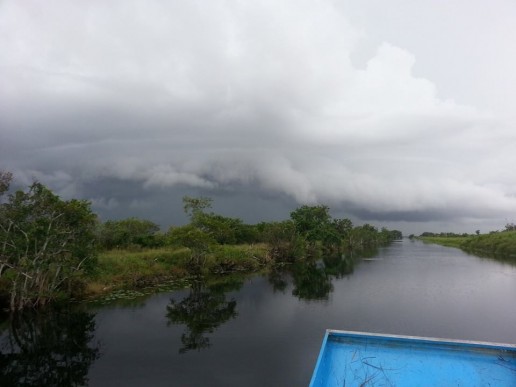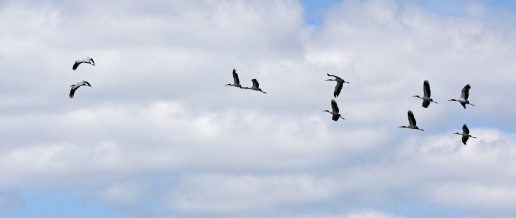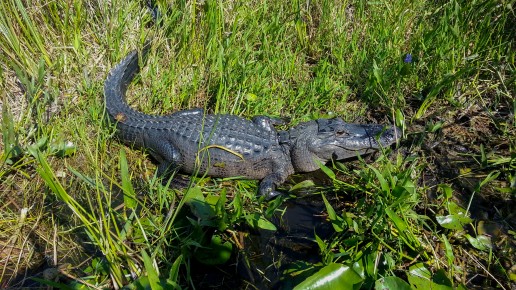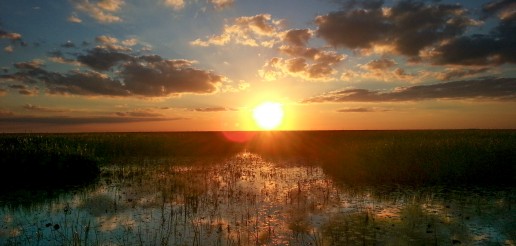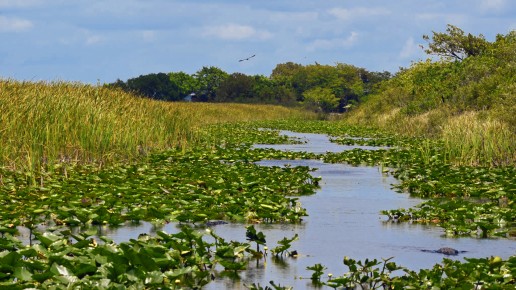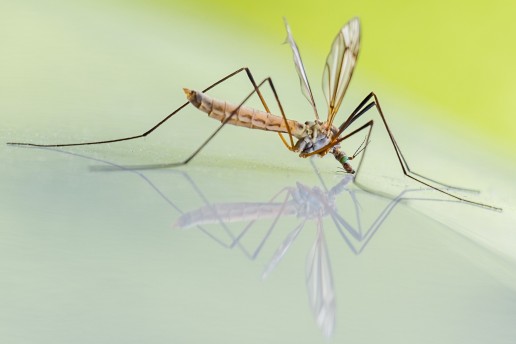Hurricane Irma Update
Just two weeks ago, much of Florida witnessed the power of mother nature when Hurricane Irma made its landfall. Despite being spared the widespread devastation seen by the Florida Keys, South Florida took its licks, too. However, Mack’s Fish Camp is still standing!
As of this past weekend, we finally have power back, but have still been offering airboat rides during the outage. Not only were we still standing, but up and running as well. That’s right, we have still been running private airboat tours and offering our bass fishing guide service in the Everglades. In fact, our airboats have made for formidable leaf blowers, helping us with clearing much of the foliage.
Like much of South Florida, our trees sustained the heaviest damage. But our old structures are still intact, including our home, for which we are very grateful. Looking at the devastation experienced by people in Texas and the Keys, we feel blessed to still have our home and each other.
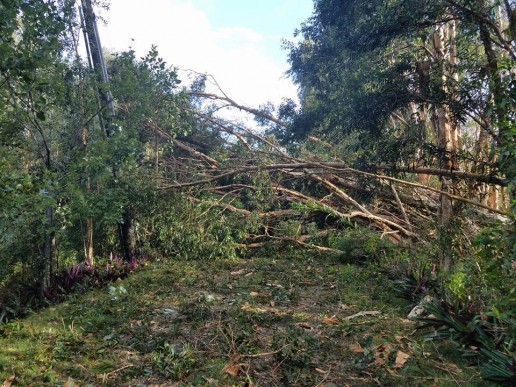
No storm can take down Gladesmen Culture
As a family of Gladesmen, we thrive in times like these through our toughness, tenacity, and a bond that no wind can uproot! But as a small, family-owned business, Mack’s has stayed alive through word-of-mouth, and we sure could use some now.
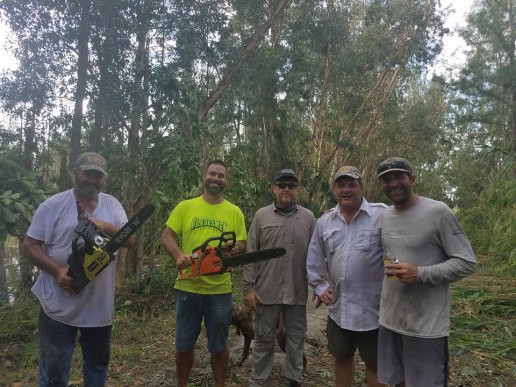
We took a hit with this storm. So, now we’re looking to you: our friends, family, and fans, to spread the word about this little piece of heaven we call home. Recommend us to a friend who’s never seen the Everglades, or bring them out here with you for an airboat ride.
Or even if you’re just curious to see the result of the awesome power of nature against its otherwise calm beauty, come pay us a visit. Rest assured that as long as the Florida Everglades are around, you can bet us Gladesmen will be, too!
5 Ways Hurricanes Can Affect Everglades Wildlife
The arrival of September means the beginning of the end of summer. But for Florida, and several other southern states, it signifies the peak of Atlantic Hurricane season. Hurricane season lasts from June 1st until December 1st, with the most activity usually occurring between late August and mid-October.
Because Florida is a narrow peninsula, The Everglades can feel the effects of a direct hit by a hurricane. Unfortunately, the Everglades wildlife and ecosystem can feel the brunt of the storm as strongly as humans can.
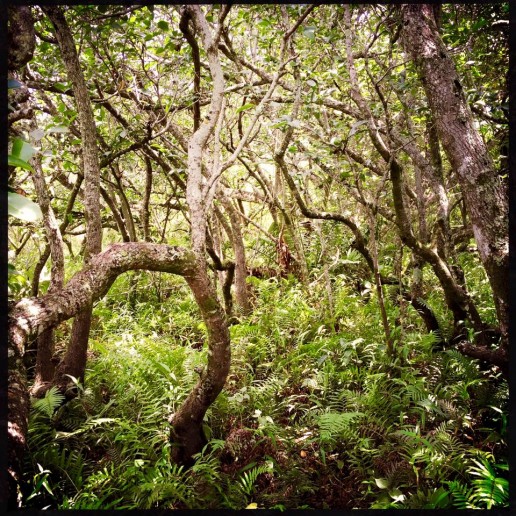
Heavy Rains Can Cause Freshwater Floods
Large amounts of rainfall from hurricanes can flood river basins near coastal areas. The excess water carried along these watersheds could surge into saltwater estuaries. This can offset the balance of saltwater and freshwater, and hurt the ecosystem of the coastal Everglades habitat.
Saltwater Intrusion Caused by Storm Surge
Hurricane winds can be so strong that they cause coastal water to surge far past the shoreline. Along with the flooding damage, the saltwater carried inland can harm freshwater wetland areas. Plants and animals aren’t as salt-tolerant in freshwater marshes and estuaries, and can suffer damage if the seawater doesn’t drain quickly.
High Windspeeds Can Destroy Tree Habitats
Everglades wildlife have specific niches in the diverse habitats here. Powerful hurricane winds can damage hammocks and forests, which not only destroys the animals’ homes, but their food as well. The potent wind gusts can strip berries and nuts from trees.
Storm Winds Can Dislocate Wildlife
The powerful wind fields contained in hurricanes can push birds hundreds of miles off course and far away from their habitats. Some birds get trapped inside the eye of these tropical cyclones, and held there by the extreme winds until it dissipates. Marine mammals like manatees can be blown onshore, too.
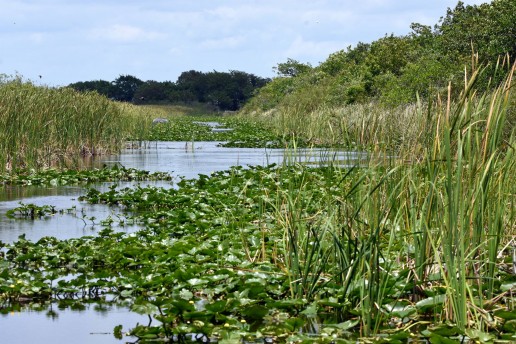
Rough Seas and Storm Winds Harm Marine Wildlife
Storm surge, combined with the rough seas caused by strong winds, are a direct threat to aquatic life. In 1992, Hurricane Andrew killed 182 million fish in the Everglades basin, and nearly 10 million more fish in the waters offshore of Louisiana.
As harsh as Mother Nature can seem to the creatures that live in the Florida Everglades. But, understand that these animals were here long before people, and have adapted to endure all kinds of peril. Taking an airboat eco tour lets you see the varieties of Everglades wildlife that thrive here, much like the tradition of Gladesmen Culture that has been here for generations.
Tips to Spot Everglades Wildlife on an Airboat Tour
The Florida Everglades is filled with an impressive variety of wildlife, including birds, reptiles, and even mammals. You may spot many animals out in the open, and some hiding in the sawgrass while taking an Everglades airboat tour in Miami. But there are a few things to do and consider before taking an airboat ride that will help your chances.
Consider the Time of Year
Everglades Birdwatching
Over 350 species of birds have been sighted in the Everglades. The largest and most diverse concentration of birds occurs here during Everglades dry season, from December through mid-May. The cooler air brings in migratory birds like bluebirds from the north, and even tropical birds like Flamingos from the Caribbean. The lower water levels of the dry season help local wading birds like the Great Blue Heron and Roseate spoonbill nest and raise their young.
But, we can’t forget the most famous species of Everglades wildlife…
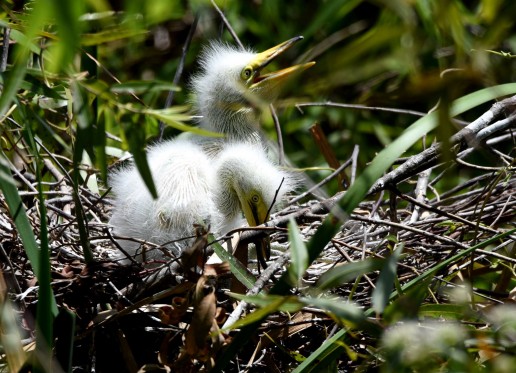
Best Time to Spot Everglades Alligators
Alligators often prefer the cooler temperatures of the dry season, but are active for much of the year. Alligator mating season in the Everglades lasts from mid-April through May, followed by nesting season from June and July. By August, you’ll see baby alligators swimming and hear their tiny roars coming from the sawgrass.
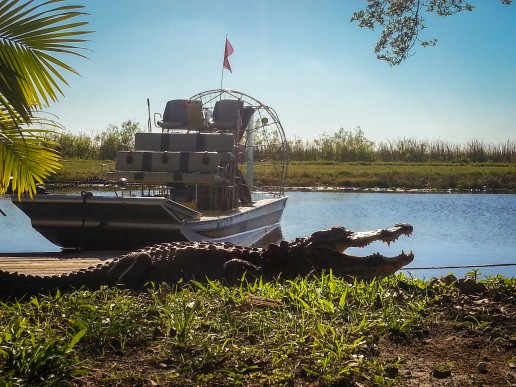
Become Familiar with Everglades Wildlife
When you take an Everglades airboat tour in Miami, you will be guided be true blue Gladesmen that are very knowledgeable of Everglades wildlife. They can help you identify animals and answer questions you might have about them. But, if you do a little studying on the animals you’d like to see beforehand, you can spot them on your airboat ride more easily.
Consider the Temperature
With average temperatures in the 80’s or higher, the summer in South Florida can get very hot, especially for the animals. Summer temperatures can also stretch into late spring and early fall, too.
Like Florida’s human residents, most animals spend much of the day trying to keep cool and avoid the sun. As a result, many birds and other Everglades wildlife are most active in the morning and early afternoon during the summertime.
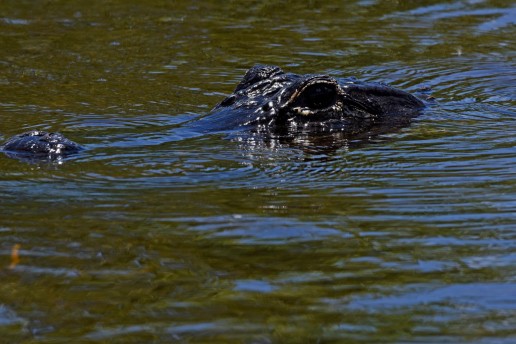
Keep a Lookout for Movement
Alligators can spend a lot of time in the water, and can be so still they’re often mistake for logs! That ripple you just saw in the water might not have been a large mouth bass. Wading birds like egrets and herons also stalk their prey so slowly that you can miss them standing by the cat tails and sawgrass.
And keep an eye out for color differences of objects you see against each other. Birds can’t be sneaky and pretty at the same time if you’re watching closely!
As incredible as the Everglades are, the biodiversity of this ecosystem makes it even more unique. It’s a sure bet that you’ll see a good number of animals while airboating in Miami. Make sure to keep an eye out for them, and remember that timing is everything!
Keep the season and time of day in mind when planning your Everglades trip. But no matter when you take your airboat ride at Mack’s Fish Camp, you’ll get to see these animals up close and in their natural habitat.
Islands on The River of Grass: Everglades Tree Islands
There is a common misconception that the Florida Everglades is just a giant, grassy swamp. It’s actually made of several different habitats, each full of distinct flora, including trees. When you visit the Everglades, you’ll notice many clusters of trees standing tall against the wet prairie and sawgrass marsh. These small hammocks are known as Everglades tree islands.
What Are Tree Islands?
Tree islands are small forests that sit on land just dry enough for them to take root. But, there’s more to it than that. Everglades tree islands are formed on land that is elevated just slightly, in some cases only by inches!
They can be made of tropical hardwood trees, ferns, cypress, and other topical plant species. Before the Everglades were drained in the 1920’s, the freshwater sheetflow went around the tree islands. As a result, many of them have an elongated, teardrop shape, with the rounded end pointed toward the water flow.
A Shelter for Everglades Wildlife
Being the only spots of dry earth outside of the pine rocklands and hardwood hammocks, tree islands can act as a dry oasis for Everglades wildlife. Reptiles, birds, and mammals that feed in the wet prairie use them for shelter to rest or hide from predators.
Many birds, including the Everglades snail kite, nest on these islands. White tailed deer also frequent them, because if they spend too much time in water they can develop hoof rot, which can be fatal.
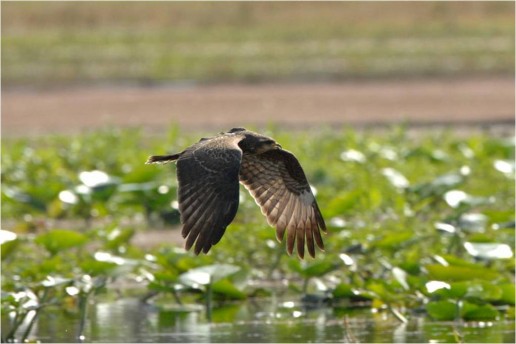
Where Did They Come From?
The ground that Everglades tree islands rest on was long-believed to be bedrock that slowly rose over time. It was recently revealed by a team of scientists that these spots were middens, garbage piles from centuries-old human settlements. The researchers found bones, shell tools, and charcoal, which would’ve helped create an elevated dry area where plants could grow.
The phosphates from the bones acted as fertilizer, and the roots reached further into the bedrock for water. This setup helped tree islands to not only form, but continue to thrive now!
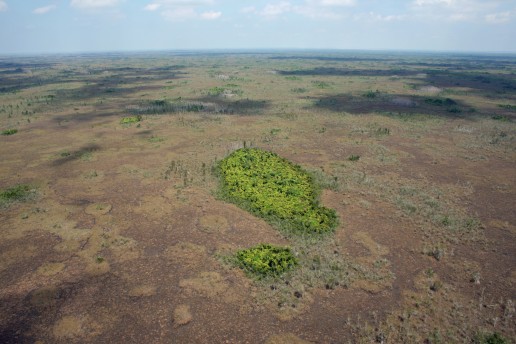
Everglades tree islands don’t just add an air of mystery to this ecosystem. They enhance its unique beauty as well as its elevation, and also provide homes to countless animals. Taking a private airboat tour at Mack’s Fish Camp can give you the chance to see them up close!
Marjory Stoneman Douglas: Defender of The Everglades
You may know that the Florida Everglades spans over 2 million acres. But did you know that it was once over 11 million acres in size?
That remaining 2 million acres is there thanks in large part to the efforts of Marjory Stoneman Douglas.
After publishing her famous book, “Everglades: River of Grass”, she worked to raise awareness of the Everglades ecosystem. She also pushed back against development in the Everglades, and devoted much of her 108 years to protecting it.
Arrival in Miami
Born April 4, 1880 in Minneapolis, Minnesota, a short and ill-fated marriage got Marjory to reunite with her father in Miami in 1915. Her father was the founding publisher at the Miami’s first newspaper, known today as The Miami Herald. She served in the Navy Reserve during World War I, and was the first woman in Miami to enlist. Marjory left the Herald in 1923 and worked as a freelance writer, which lead to the writing of her most famous work.
The Everglades: River of Grass
While working as a freelance writer in the 1940’s, Marjory was approached to write about the Miami River. As she researched the story, she became fascinated with the Everglades and began researching them too!
In 1947, Marjory published “The Everglades: River of Grass” The book details the system of water flow from the Kissimmee River through Lake Okeechobee into the Everglades. Marjory explained that the Everglades wasn’t the swamp that most people though it was, but a slow-moving river!
From Writer to Conservationist
With the attention and support she received upon the publishing of “River of Grass”, Marjory became directly involved with Everglades conservation. She devoted herself to preserving the sheet flow of the Everglades and educating people all over Florida to be aware of its importance. In doing so, she rallied many to Everglades conservation, which lead to the founding of Friends of the Everglades in 1970, which Marjory was the head of.
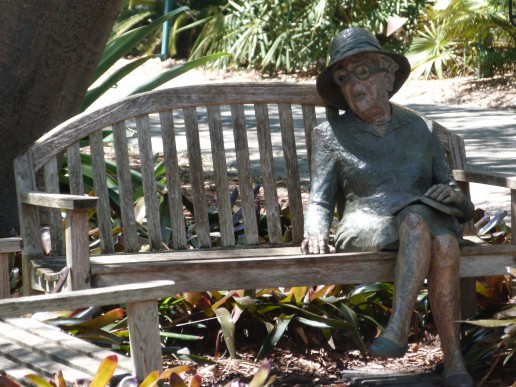
The legacy of the Gladesmen Culture is traditions built upon the marshes and limestone of the Everglades. The passion, commitment, and drive of Marjory Stoneman Douglas forged her legacy, which is the preservation of this ecosystem. Without her tremendous efforts, the Everglades would be just a memory. When you visit Mack’s Fish Camp, we get to share both of our legacies with you.
5 Surprising Facts About Alligators
Alligators may not be colorful like herons, or be cute and small like green tree frogs. But the power, agility, and strong presence they display in the wild fascinate both locals and Everglades visitors alike. Taking an airboat eco tour, you can learn many interesting things about Everglades alligators. For now, here are a few things you might not know about these living dinosaurs.
They Can Jump… and Climb!
In addition to being nimble swimmers, alligators can jump six feet into the sir from a resting position! This leaping ability is mostly for ambushing prey near the water. But they can use it to grab onto tree branches and climb to their prey.
Having that much mobility could mean one of the most dangerous places to be is between an alligator and a meal. Don’t worry, though. They have a natural fear of people, which is fortunate because…
Alligators are Fast Runners
Alligators prefer to stay in or near water, and their strong tails help them swim at a speed of up to 20 to 30 miles per hour (MPH). But if they see a potential meal hanging out near the edge of the water, they can bolt after it on land. As big and heavy as they are, alligators are capable of moving in short bursts up to 15 MPH on land.
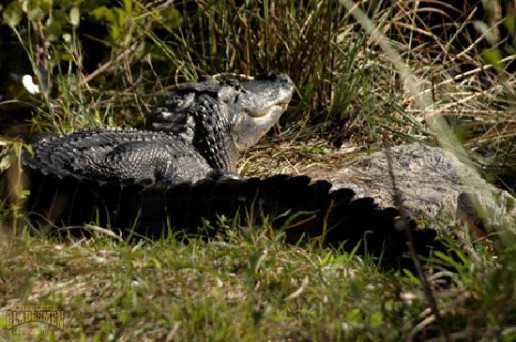
The Sex of an Alligator is Determined by the Temperature of its Nest
Like some reptiles, the temperature of an alligator’s nest determines whether the alligators will be male or female. A temperature below 82.4 degrees Fahrenheit will produce females, and a temperature above 91.4 degrees Fahrenheit will produce males. An even number of both males and females will be produced if the temperature is near 87.8 degrees Fahrenheit.
They Help Maintain the Everglades Ecosystem
Despite their beastly hunting instincts and solitary nature, Everglades alligators give back to their community, whether they realize it nor not. In fact, that solitary nature helps other Everglades wildlife thrive.
When alligators make their homes, called alligator holes, they clear old vegetation away in the marsh. This makes room, for new growth after they abandon their dwelling. Abandoned alligator holes also serve as an oasis to birds and fish during the Everglades dry season, when water becomes scarce.

Everglades alligators are not only the most iconic of all the animals here, but the most significant. While they are wild animals and formidable predators, their shyness around humans makes them perfectly safe to view on an Everglades airboat tour.
Just don’t feed them, or even your running shoes might not save you
4 Everglades Animals People Haven't Heard Of
Of the many species of wildlife that live in the Everglades, there are only a few that are well-known. The American alligator, Florida panther, and many wading bird species are the first animals people associate with the Florida Everglades. There are also several other Everglades animals native to Florida that make their home here as well, but are overlooked. Here are four of these Everglades hometown heroes.
Everglades Snail Kite
This medium-sized bird of prey differs from other raptors, as it feeds on mollusks, primarily snails. Snail kites are easily identified by their slender, curved bills, which help them to easily extract apple snails, their primary prey, from their shells. Their very specific diet depends upon the water levels and water quality of the Everglades, and they are listed as endangered due to habitat degradation affecting apple snail populations.

Florida Black Bear
The only species of bear found in Florida, the Florida black bear has adapted to living in a subtropical habitat. It mostly thrives on acorns, palmetto berries, nuts, and holly as well as colonial insects like ants, termites, bees, and wasps. During their breeding season in the summer, black bears consume 5000 calories a day! Florida black bears favor habitats that have a dense understory, and can be found in the forested sloughs, oak scrubs, pine rocklands, and other wooded areas in the Everglades.
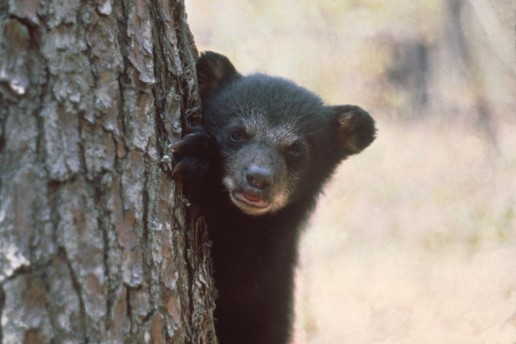
American Purple Gallinule
This colorful bird is found in marshes throughout the tropics, but it’s only year-round residence in America is the Florida Everglades. Named for its mostly purple feathers, its green back, red and yellow bill, blue forehead and long, yellow legs make it a walking rainbow. The purple gallinule also has very long toes to allow it to walk on lily pads and floating vegetation without sinking.
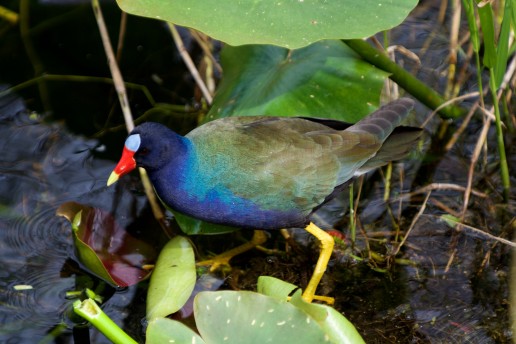
Everglades Mink
One of three species of mink living in Florida, the Everglades mink can be found in swamps and freshwater marshes. These aquatic mammals are nocturnal hunters and fierce fighters, capable of attacking prey larger than them. Everglades mink activity has been observed to increase before storms and other changes in weather.
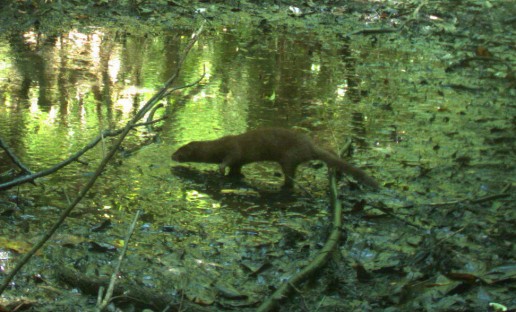
These Everglades animals might not have the star power that alligators and roseate spoonbills do, but their uniqueness to the Florida Everglades makes them equally as important. When you take a private airboat tour at Mack’s Fish Camp, you get a chance to see the magnificent creatures in their natural habitat. Like the Gladesmen Culture that has thrived here for generations, so do countless animal species.
Everglades Airboat Tours: Summer Fun Close to Home!
Going into late July, we’re entering the dreaded “Dog days of summer” in South Florida. You’ve probably taken a family summer vacation out of town, and the kids will be headed back to school in a few weeks. With summertime running out and starting to drag, you might be feeling the itch for one more adventure. So, why not seek it in your own backyard? Everglades airboat tours are a great way to have some late summer family fun in Florida without the theme park price tag
Exciting and Educational All Ages Fun
Taking an airboat ride in the Everglades can be a blast for all ages. Young or old, toddler or teen, Everglades airboat tours provide excitement and exploration for all ages. With a born and bred, fifth-generation Gladesmen as your guide, you’ll learn a lot about the Everglades ecosystem and the over 350 animal species that thrive here.
Theme Park Thrills Without The Lines
While Florida theme parks are bursting with attractions and rides, they’re also bursting with large crowds in the summer. Lines and wait times can be up to 2 hours long for rides that last for only a few minutes. In South Florida, the Everglades is a hidden gem just west of the sunny beaches of Fort Lauderdale, Hollywood, and Miami. When you come to take a private airboat tour at Mack’s Fish Camp, the ride is waiting for you, never the opposite.
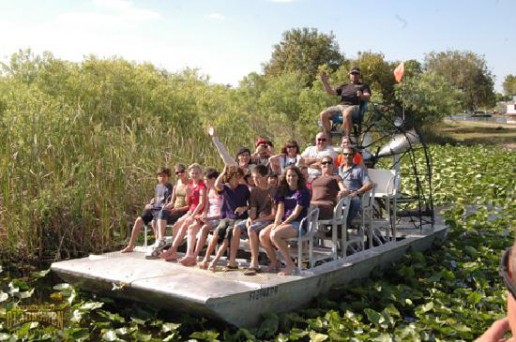
With the many northern visitors Florida receives during the winter, it’s no secret that Florida is warm year-round. The increased humidity coupled with rising temperatures can make even a trip to the beach a tiring ordeal, and The Everglades can feel the heat, too.
In the summer, Everglades airboat tours are best-enjoyed in the morning until noon and in the late afternoon. In addition to the temperature being more hospitable to people then, much of the Everglades wildlife, like the many bird species residing here, are more active then. Also, if you take an airboat ride later in the day, you can witness a vivid, wildly colorful Everglades sunset.
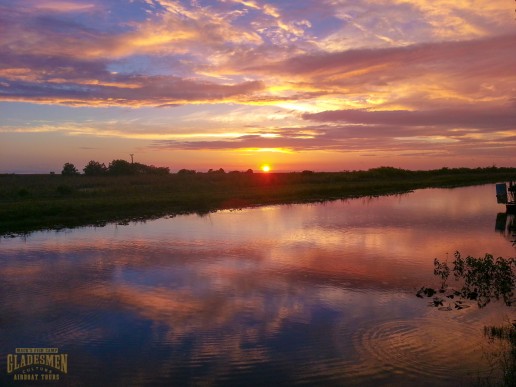
Beat the Heat and See Real Florida Magic
Time and money can take on more importance as summer break draws to a close. Even with the school year looming large, you want to make good use of that extra time with your family. If you live in South Florida, taking an airboat ride at Mack’s Fish Camp in the Everglades is an exciting and affordable way to do that while staying close to home.
5 Everglades Plants You Should Know About
There are several different habitats that make up the Florida Everglades, each with its own distinct plant life. The biodiversity of Everglades plants in these habitats promotes the equally diverse animal life that resides in them. The flora found in the Everglades ranges from beautiful, to strong, and in some cases dangerous. Here are 5 standout Everglades plant species you should know about before your visit!
Everglades Flowers
Spider Lily – This Florida native is easily identified by its long, white, curving sepals and pedals, that are connected by a gossamer web. These fragrant Everglades Flowers are found growing in swamps, marshes, and hammocks year-round, and are very drought resistant.
Ghost Orchid – There are several orchid species growing in the Florida Everglades, but the ghost orchid is considered a symbol of the lush variety of Everglades plants. It has long, delicate, white petals, and due to its complex shape, can only be pollinated by the sphinx month. Found in cypress swamps, these Everglades flowers use their massive, tangled roots to cling to palm, pond apple, and cypress trees.
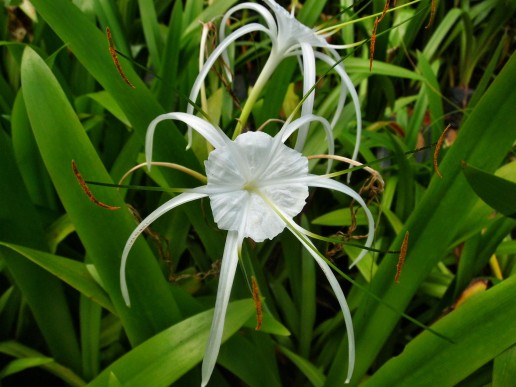
Everglades Trees
Cypress Trees – This is tree is the most flood-tolerant of Everglades trees. Found in swamps and in tree islands on marshes, cypress trees have large ”knees” that protrude as high as 6 feet above their roots. These knees allow for oxygen to reach the roots and support the trees in water-logged soil.
Mangrove – This rooty plant is located toward the coastal areas of the Everglades. Mangroves act as a buffer between the saltwater of the coast and the freshwater marshes. Their strong roots help reduce soil erosion from ocean currents, block waves, and restore the soil through their cycles of growth.
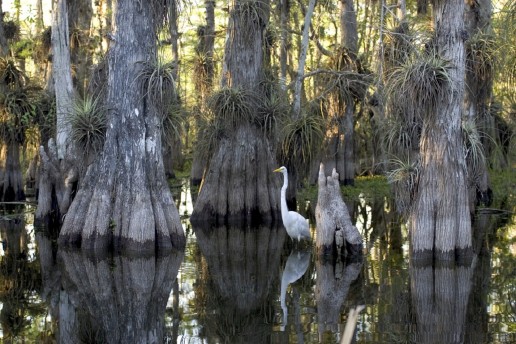
Poisonwood – The Tree to Avoid
The Everglades have many plants to behold, but also a few you should try to avoid. The poisonwood tree is best identified up close by their teardrop-shaped leaves outlined in yellow, which appear to droop from its branches, but watch out! The tree contains 100 times more poison in its bark, sap, and leaves than poison ivy, and touching them can cause skin inflammation and blisters.
It’s best to avoid hiking in the Everglades hammocks in the rain, because the sap from a poisonwood could drip on you. The safest way to view poisonwood trees is on an Everglades airboat tour from a safe distance, because any contact with them should be avoided.
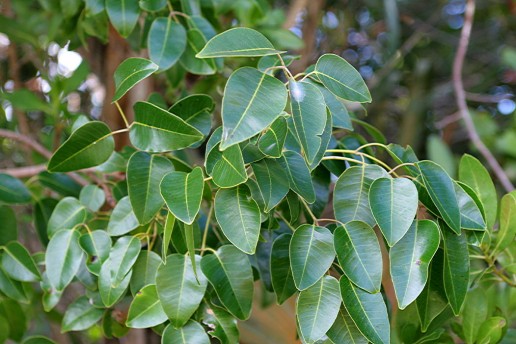
The various habitats in the Everglades promote a wide range of unique plant life here. The many Everglades plants growing here range from resilient, to pretty, and also hazardous. But by exploring the Everglades on a hike or private airboat tour can give you the chance to see several of them.
Mosquitoes In The Everglades
Mosquitoes are easily the most disliked animal in the Florida Everglades. Their buzzing and biting makes them a nuisance to people, especially during the Everglades wet season. While taking an Everglades eco tour, you may be surprised to learn that even they play a part in maintaining their environment. But here is some information about these insects to help you understand them and prepare for them before your Everglades visit.
Some Information About Mosquitoes
Mosquitoes are easily are most abundant during the Everglades wet season from May through summer. But their numbers drop significantly during the drier winter months. The wet summer months see peak mosquito activity because both their larvae and eggs can only thrive in water.
Male mosquitoes only feed on flower nectar.
Females bite animals for protein to develop their eggs.
A nuisance only to humans, the mosquito is a vital link in the Everglades food web. By laying their eggs in the water, their larvae are a food source for fish, turtles, frogs, wading birds, and other insects.
Mosquito Safety In the Everglades
Given the abundance of mosquitoes in the Everglades, you should take precautions to avoid their bites as best you can. When you take an Everglades eco tour or any other private airboat tour at Mack’s Fish Camp, we do provide bug repellent. But here are some tips to avoid mosquito bites when you visit the Everglades.
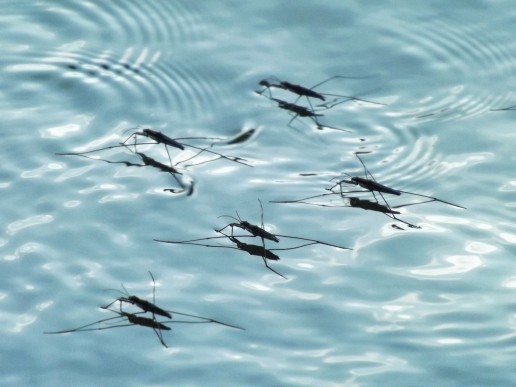
- Stay in the sun and avoid shaded areas. Those tiny vampires love shady spots.
- Don’t breathe… heavily. Mosquitoes are attached to carbon dioxide, and the harder you breathe out, the easier it is for them to find you.
- Wear light colored clothing. In addition to being a good fashion choice for the Florida sun, mosquitoes are less attracted to them. They are drawn to darker colored clothes like navy blue, black, or red.
- Avoid dense vegetation and bodies of standing water. Mosquitoes are concentrated in these areas (vegetation) or are their breeding grounds (water).
The Everglades is Zika-Free
While they are known carriers of disease, there have been no reported cases of mosquitoes in Everglades carrying the Zika virus. In fact, after collecting over 400,000 mosquitoes in the Everglades, a team of Yale scientists found no Aedes egyptii species, the known carriers of Zika.
Though considered a pest to people, mosquitoes are a valued part of the Everglades ecosystem. If they prove too overwhelming when you visit the Mack’s Fish Camp, then maybe you should explore it on an Everglades eco tour. A mosquito may be able to fly 40 miles for a snack, but it sure can’t keep up with an airboat!


